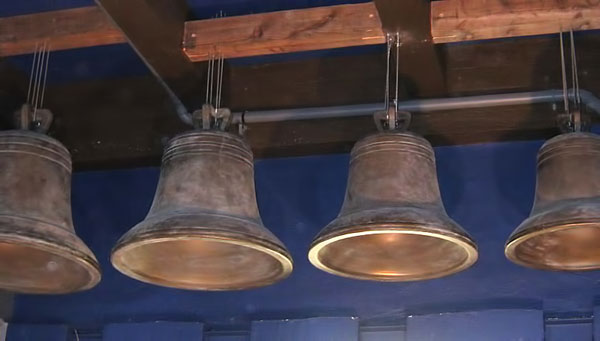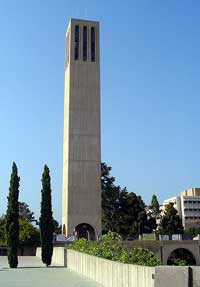|
Bells
Our Seth Thomas tower clock was built to strike bells when it was made in 1929. But the bells were never bought, so the striking mechanism was never fully assembled or operated. In the current restoration, we are now running the complete striking mechanism on replicas of the bells that would have been used. Real bells would cost hundreds of thousands of dollars and they would deafen the tourists on the observation deck. Since these fiberglass and styrofoam bells make no sound, I devised an electronic system to play the bell sounds.
To acquire bells sounds I approached the music department at UCSB, which has a carillon in Storke Tower. As it happens, the UCSB Center for Research in Electronic Art Technology (CREATE) had recently made exhaustive recordings of the carillon bells. Dr. Matthew Wright, the Research Director at CREATE, generously made these recordings available to me for use with the Courthouse clock. For Westminster chimes we needed the following notes: G#, F#, E, B, and E an octave lower. The carillon had all of these notes except the low E. I was able to use software tools to drop the pitch of a "B" bell to a low "E". I programmed these individual bell recordings into five electronic circuits that play the sound files when triggered by a magnetic sensor mounted on the strike and chime levers of the clock. The Santa Barbara Courthouse clock once again plays Westminster Chimes, with digital recordings of the UCSB carillon bells. For comparison, here is the digital recording that was previously used in the Courthouse clock. After hearing the UCSB carillon bells, it sounds more like a doorbell than a clock tower! In the clock room, the mechanism of the clock makes a lot of other noises while the clock is striking. The drive weights fall, hammers are pulled back and strike their retaining springs, giant fan blades spin to control the speed of the chime, and motors wind the chime and strike trains to raise the massive weights that pull the hammers. Here is a recording of the actual clock striking five. It starts with the clock quietly "ticking". Then the chime train is released. The weight begins to fall, and the clock plays Westminster as the hammers smack their springs and trigger the digital bell recordings. The motor comes on and rewinds the chime weight while it is playing. The clicking sound at the end of the chime is the ratchet on the chime train fan clicking as the big blades come to rest. Six seconds later the strike train is released and the weight falls as the big "bell" strikes five. You also hear the motor rewind the strike weight. The clock then ticks quietly until the next quarter hour. Guitar bells
Ringtones
|

